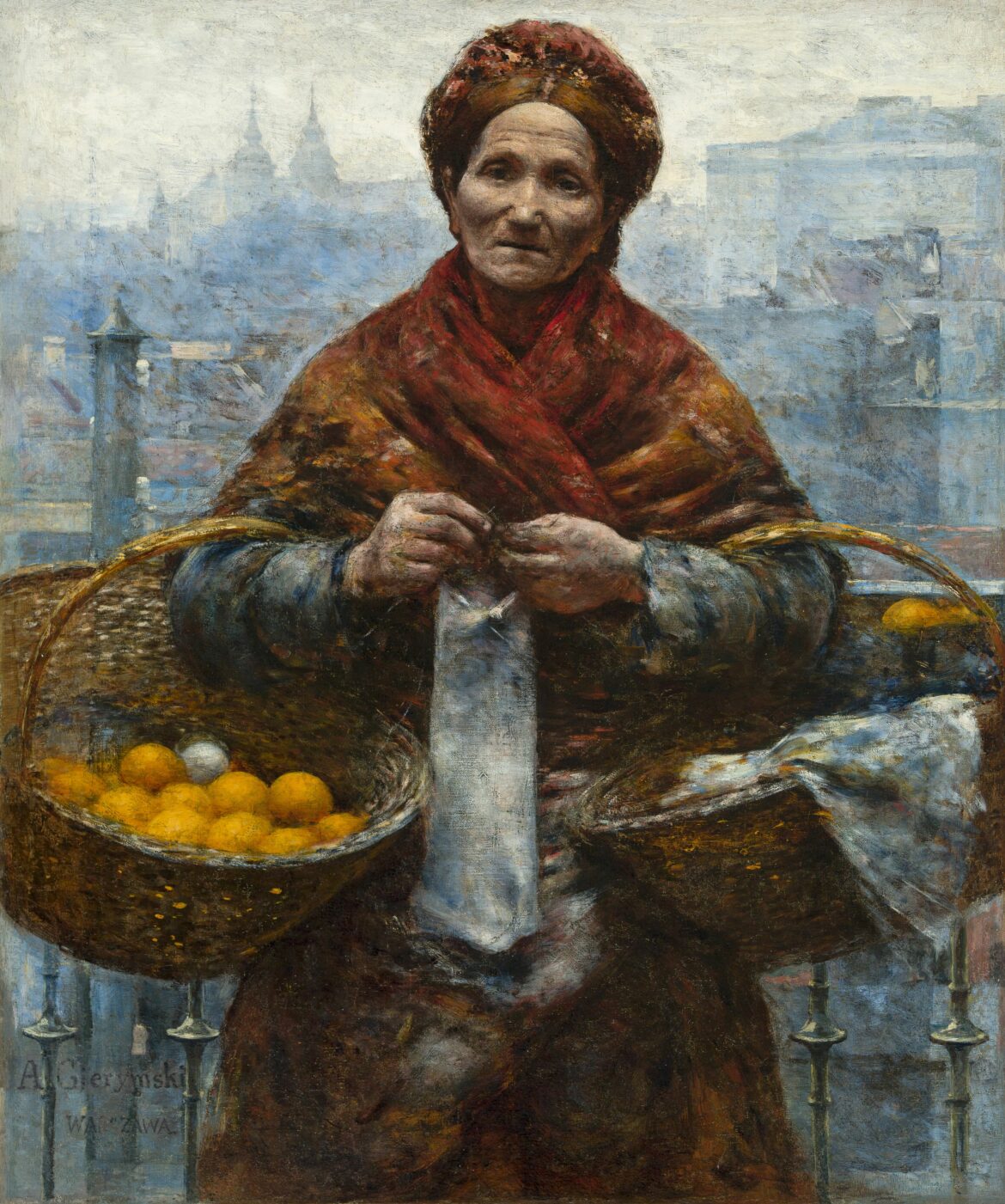During World War II, the Germans looted many Polish works of art and many of them have not yet been found. It seemed that the “Jewess with Oranges” – a painting by Aleksander Gierymski did not avoid a similar fate. However, it was changed by an auction in Germany in November 2010.
Living in Warsaw in the years 1880- 1881, Aleksander Gierymski painted “A Jewess with Oranges”. At that time many Jews lived in Warsaw occupied by Russians. This painting is considered a masterpiece and one of the most important Polish works showing the Jewish presence in Poland.
Contrast and seriousness
In the foreground, the painting shows a Jewish merchant old lady holding two baskets of oranges. She wears poor clothes and has a bonnet on her head and a scarf around her neck. The woman’s face is serious, even worried and sad. This impression is enhanced by her expressive cheeks and wrinkles. Vivid colors highlight the figure and oranges are especially accentuated. These colors contrast very strongly with the background of the 19th-century Warsaw buildings painted in pale hues of foggy colors.
A masterpiece of realism
This work belongs to the realistic trend. The aim of realism in painting was to mirror reality very accurately. Looking at Gierymski’s “Jewess with Oranges”, viewers can get the impression that it is not a picture, but a photograph.
The author himself wrote about his painting in 1884: “The Jewess” was perhaps my best painting (…). Devilishly colorful and malleable. Perhaps I’m exaggerating, but if I seriously return to painting, I will deal with large or medium-sized figures only- no landscapes”.
A gift for a friend
Painted the picture, Gierymski gave it to his friend: Prosper Dziekański. This nobleman and veteran of the January Uprising died in 1922. Then, the “Jewess with Oranges” was obtained by his son-in-law, Ludwik Zagrodzki. At one point in his life, however, he needed cash and decided to put it up for auction. The masterpiece was acquired by the Polish National Museum in Warsaw. It was supposed to be enjoyed by art lovers for many years, but soon World War II broke out.
Robbery of works of art
As a result of the aggression of the Third Reich and the Soviet Union in 1939, Poland was conquered. The times of terror and planned extermination commenced in Poland. The occupying countries also began looting cultural goods. Many Polish works were robbed out and did not survive the turmoil of war or ended up on the black market and in the hands of smugglers.
Many German art historians came to the National Museum in Warsaw assessing the value of pictures before packing and transporting them to the Third Reich. The “Jewess with Oranges” avoided such a fate probably until 1944.
The unknown fate of the painting
On August 1, 1944, the Poles started the Warsaw Uprising, which lasted for 63 days. The reason for the uprising for independence was the brutal policy of the Germans towards Poles and the desire to independently liberate the city before the criminal Red Army. Despite of heroic struggle, the Uprising collapsed, and the German troops destroyed Warsaw, leaving ruins behind.
Presumably, the Germans robbed the work from the National Museum in Warsaw during the Uprising. It seems possible because in the notes of the director of the Museum, Stanisław Lorentz, written a few days before the end of the uprising, there is no information about the painting. The second lead is the date on October 6, 1944, when the Germans carried out a hasty transport of works from occupied Poland to the Fischhorn Castle in Austria. However, these are only guesses and the historians do not know the exact fate of the masterpiece. The painting was lost and it seemed that it would never be found again.
Unexpected find
In November 2010, a painting was exhibited at an auction in the small town of Buxtehude near Hamburg. The owners of the auction house asked the Silesian Museum in Katowice for an expert opinion, because the collection of this institution contained a very similar work entitled “A Jewess with Lemons” by Gierymski. Experts from the Silesian Museum had no doubts – the painting put up for auction in Germany was “A Jewess with Oranges” stolen by the Germans from Poland during World War II. The information was submitted to the Ministry of Culture and National Heritage in Poland. The Polish prosecutor’s office was also involved in the case.
Picture returns to Poland
The woman who put the painting to the auction inherited it from her grandmother. She explained that she was not aware that the work had been stolen by the Germans from occupied Poland. In 1948, her grandmother married an industrialist and collector from Düsseldorf. Perhaps he had acquired the painting earlier, but nothing is known for certain.
As a result of negotiations, the picture “Jewess with Oranges” returned to Poland in 2011. Before the painting was admired by art lovers, in December 2012 it had undergone restoration work that lasted 440 days.
The painting is presented now in the National Museum in Warsaw in the “Gallery of 19th Century Art” alongside other paintings by Gierymski.





